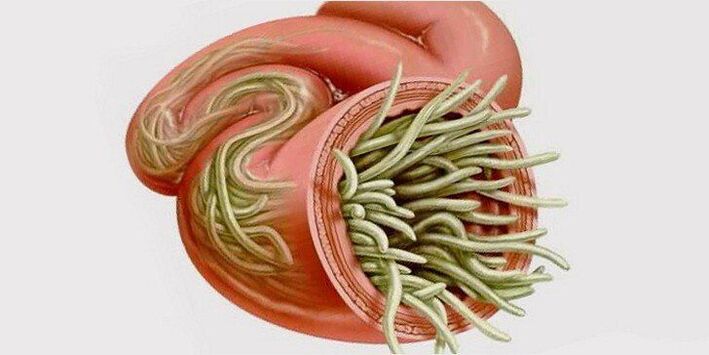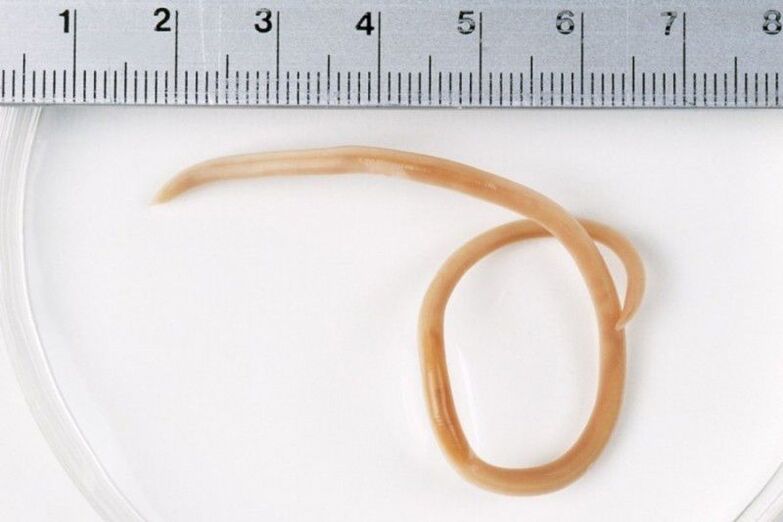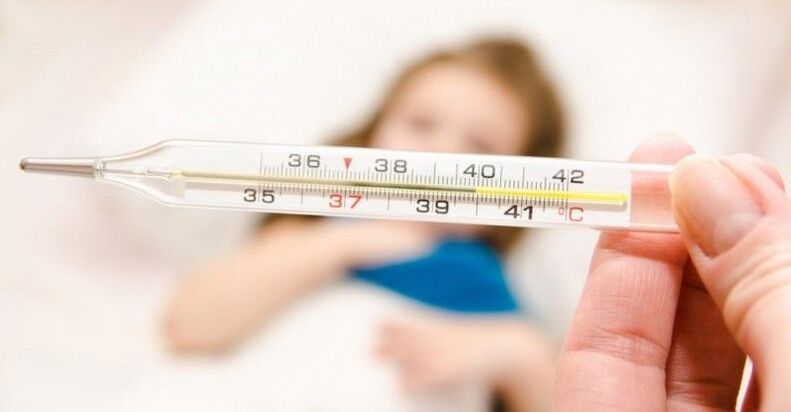
When worms enter the human body, they begin their parasitic activity, thereby making a person feel unwell. Helminthic attacks often cause severe allergic reactions, gastrointestinal diseases and other pathologies not related to the gastrointestinal tract. However, traditional treatment of this disease does not bring recovery. Worms in humans can be suspected with a high probability based on certain symptoms, but helminthiasis clinically manifests itself only when the worms multiply massively. In the case of asymptomatic cases, laboratory tests will help to reliably diagnose helminthiasis. Symptoms of worms in humans can be different, but first of all, abdominal pain, discomfort near the anus, nausea, and general lethargy appear. To restore good health, it is necessary to get rid of worms using anthelmintic drugs or folk remedies.
What is a worm?
Worms are parasites of humans and animals that belong to the class of flatworms or roundworms. Worms have a fairly common structure.
In its development, worms traditionally go through several stages: egg - larva - adult. Most infections of a person who has worms occur when he ingests worm eggs.

Eggs that are swallowed in the human intestinal tract quickly hatch into larvae, which begin to migrate to the place of their eternal life, where they turn into adults. In the process of movement, almost all helminths make a true "journey" through the human body.
Only some parasites (for example, pinworms) hatch from eggs in the intestinal tract and remain there. Usually, the destruction of tissues and organs and the symptoms caused by the larvae and other developing forms of helminths during movement are the most significant, compared to the symptoms caused by the mature form of the parasite.
As we said above, adult worms traditionally have a stable localization in the body, and their developmental form often migrates to different organs and tissues, and often the path of movement is quite complicated. For example, with ascariasis, a person becomes infected by eating food contaminated with worm eggs (ascaris eggs ripen in the soil).

In the cavity of the intestinal tract, roundworm eggs hatch into larvae, which within a few hours pass through the wall of the intestinal tract into the blood vessels and are carried to the lungs via the bloodstream. In the lungs, roundworm larvae grow and mature. The growing larvae slowly gnaw the adjacent bronchi and crawl along them, first into the trachea, and then into the oral cavity, where they are again swallowed and carried into the intestinal tract.
Roundworm larvae that enter the intestinal tract turn into adult worms. Lung migration of roundworm larvae is indicated by many symptoms (cough, asthma attack, increased body temperature, allergic skin rash), and the presence of a small number of adult worms in the intestinal tract may not be manifested in any way.
What are worms? Worms are scientifically called helminths. Helminths means any worm that parasitizes the body of humans, animals and plants. Accordingly, worms are not a specific type of parasite, but a whole group of different worms, three of which are the most common.
Some scientists claim that almost the entire population of the Earth is infected with one or another parasitic worm. However, in this case, helminthic attacks must be the most common type of disease in the world, and, moreover, some serious studies prove that in fact everything is not so bad. But the thought that a person still has helminths makes him immediately look for an answer to the question of how to get rid of worms.

It should also be understood that helminthic attacks are not rare and insignificant. There are more than three hundred species; larvae in humans enter far outside the intestine and continue to develop there, gradually poisoning the body. Let's think about what are the symptoms of worms in humans, because the warned, as we know, is armed. And then we'll find out how to get rid of worms effectively and what it takes to make sure they don't come back.
It is actually very easy to determine the presence of worms in the body of any person - you just need to take a stool test. However, the problem is that most people don't think to go through such a test. The problem is that helminths in adults and children appear, disguised as a large number of diseases, and at first they do not reveal their presence at all.
A person can spend years treating the intestines, liver, kidneys, stomach, gall bladder, and the cause of evil will be helminthiases and parasites, which feel great when they are not fought.
Often, helminth attacks cause the development of diseases that have nothing to do with the helminths themselves. And in this case, you can be treated endlessly if you do not understand in time what is happening.
All this proves that worms are not just an unpleasant phenomenon. And given the presence of a large number of ways of infection, knowing the signs of worms in humans is very important.
How do worms (parasites) appear?
Symptoms of helminthic diseases depend on the phase of parasite development. The development of helminthiases is usually divided into acute and acquired stages.
- The acute stage of parasite development begins from the moment the patient is infected with worms and lasts for 2-3 weeks (in case of severe disease - up to 2 months).This stage is characterized by the predominance of allergic manifestations (rash, suffocating dry cough, increased level of eosinophils in the blood), which develop in response to the appearance of larval antigens (fragments) migrating in the blood. The immune response is most pronounced at the stage when the initial form of the parasite (larvae) is in the body of the infected person;
- The developmental stage of acquired worms occurs after the acute stage and lasts several weeks, months or years (for some helminthic diseases - up to 10 years).The symptoms of this stage for us depend on the location of the worms, their number, and feeding habits.
In the place where it spreads, the parasite damages the tissue with its fixing organs (hooks, spines, cutting plates, cuticle spines). Damage causes tissue irritation and the development of an inflammatory response.
Some parasites that grow rapidly, such as cysticerci or hydatid cysts, are in the brain, eyeball, and liver, compressing the surrounding tissue, often causing dysfunction of important organs, which leads to serious consequences.

In the stage of acquired helminthiasis, the metabolism is disturbed, because the parasite constantly absorbs valuable nutrients, such as proteins, minerals, carbohydrates, and vitamins. In addition, the absorption process of digested food in the intestinal tract is disrupted. The acquired phase in most digestive helminthic attacks is often asymptomatic, especially in cases where the parasite is represented by a single individual.
Any disease symptoms only appear when the parasites are large, such as roundworms or tapeworms.
With other helminthiases, for example, with enterobiasis, itching at night in the anal area may appear; intensive invasion with trichuriasis contributes to the development of hemorrhagic colitis; in children, symptoms of rectal prolapse may appear.
How can you get worms?
You can acquire parasites in many ways. In this case, worms are carried by larvae that are almost invisible to the naked eye.
Main methods of infection:
- lack of hygiene skills - dirty hands, working on the ground;
- eating food contaminated with helminths - unwashed fruits and food eaten by the husband, as well as meat and fish that have not been treated with sufficient heat (kebabs, rare steaks, smoked foods, sushi, etc. );
- drinking uncooked water contaminated with worm eggs;
- contact with animals that are natural reservoirs for worms - cats and dogs, wild animals (hunting, fishing, working on fur farms);
- contact with a person suffering from helminthiasis - shaking hands, through bed linen, door handles, etc.
In which organ can worms live?
Helminthic parasites are divided into two categories, which correspond to the location of activity in the body of the donor:
- cavity– worms that live in various parts of the gastrointestinal tract. There are about 100 species of intestinal parasites, and for each part of the intestine there are several dozen species. The small intestine is ready to receive roundworms, antelostoma, tapeworms and other less common "relatives". The small intestine will "share living space" with pinworms, dwarf tapeworms and others. Medical literature describes cases where one person has been infected simultaneously with several types of parasites;
- fabric- worms are localized in organs, tissues and also in the blood. Modern medicine successfully overcomes paragonimiasis (lungs), cysticercosis (brain), echinococcosis (liver) and filariasis (lymphatic vessels). Some worm larvae move throughout the body through the circulatory system and randomly attach to any organ. If many eggs are inserted, the whole body can become infected.
How can you get worms?
To protect yourself, you need to know about 4 ways to spread and become infected with worm eggs:
- through soil and water - geohelminthiasis. They develop in sand, soil and water, then enter the human body and start laying eggs there. Next, the worm eggs enter the external environment along with feces and wait in the wings to infect new people. Eating vegetables and fruits that are not washed well, dirty hands, and dust that comes into contact with food can cause a person to become infected with geohelminths. Some parasite eggs enter the human body through the skin of the feet and ankles;
- through direct contact.Worms in pets and humans are spread through hand contact, play, and shared activities.
- through the consumption of contaminated food of animal origin - biohelminthiasis. Eating raw and lightly processed meat (kebabs, lard, cured meats, home-cooked game) and fish (sushi, dried fish, cured fish) is potentially dangerous. There is a possibility of infection with intestinal infections and biohelminths;
- for insect bites. This type of infection is relatively rare. These include intestinal myiasis, canthiasis and scoleciasis. Do not confuse parasite eggs and insect larvae, which are also stored under animal skin and human skin (for example, gadfly larvae).
Symptoms of worms
To understand how to remove worms from a person, you should know the symptoms that indicate each type of tapeworm. Depending on the location of the dislocation, helminthic attack can:
- glowing.Worm-type cavities inhabit the small and large intestine. For example, the area where roundworms and tapeworms live is the small intestine. Pinworms live in the lower part of the small intestine, whipworms live in the large intestine;
- muscle (cellular).They live in muscle cells, lung tissue, brain cells, liver, lymph nodes, and eyes. Some worms are luminal and cellular, because in the early stages they migrate with the blood circulation and fill the organs above.
Symptoms of worms in adults can be different. As mentioned above, they are often confused with signs of other diseases. In some cases, everything happens according to the classic scenario of mass infection. In this case, the signs of worms in adults and children will be the same, most likely, in children - more noticeable.
Obvious symptoms of worm infection: itching in the anus, especially at night; sudden loss or, conversely, weight gain; anemia, externally shown in pale skin; tired, lethargic appearance.
If you or your children begin to experience such a phenomenon, you must visit a doctor and insist on being tested for the presence of parasite eggs in the feces. Of course, it might not be their fault. The symptoms of helminthic attack are not always to blame for poor health, but communication with a doctor will be useful in any case, because disorders in the body are obvious.
Symptoms of worms in humans, the first signs
The first sign of worms in humans is always absent; symptoms of parasite infestation only appear when there are large numbers of worms (pinworms, roundworms) or tapeworms reach a large size, for example. The clinical picture of helminthiasis often mimics gastrointestinal pathology.
However, in addition to the characteristics of gastrointestinal lesions, there are signs that indicate the dysfunction of other organs.
Symptoms that indicate the presence of helminths in the body:
- lack of appetite or, on the contrary, gluttony, bitterness in the mouth and excessive salivation;
- a strong desire to eat sweets (worms eat carbohydrates);
- nausea, vomiting - sometimes worms crawl into the stomach, or their parts (segments) are found in vomit;
- anal itching and teeth grinding during sleep often indicate enterobiasis;
- unstable stool - always provokes intestinal dysbiosis, helminthiasis occurs with frequent changes in diarrhea and constipation; with a significant attack, worms can be excreted in the feces;
- flatulence - bloating and rumbling in the stomach caused by toxins produced by worms;
- periodic abdominal pain - diffuse, often localized in the umbilical region, the pain is sometimes spastic in nature;
- skin manifestations - sudden allergic rashes and purulent formations (acne, boils), due to a decrease in local immunity and the removal of toxins through the skin, often occur in a severe form, at the same time there is weakness of nails and excessive hair loss;
- intestinal irritation syndrome - impaired absorption of nutrients leads to the development of anemia and weight loss, especially with many helminthic colonies;
- cough is a dry symptom that occurs in the pulmonary stage of helminthiasis (ascaris larvae enter the lungs with blood); severe attacks can trigger pneumonia;
- obesity - oddly enough, can also be triggered by intestinal parasites, which, when eating carbohydrates, cause a sharp drop in blood glucose and force a person to consume more food, and the body stores fat in storage;
- symptoms from the nervous system - increased irritability, lack of sleep or drowsiness, persistent depression, decreased attention and memory problems are especially noticeable in children with helminthiasis;
- chronic fatigue syndrome - parasites often cause constant weakness, a prolonged rise in temperature to 37-37. 5 C, flu-like conditions and muscle pain;
- pathology of the upper respiratory tract - moist runny nose, intractable cough, although pneumonia and asthmatic conditions are often caused by the presence of helminths;
- decreased immunity - accompanying helminthiasis, intestinal dysbiosis and chronic intoxication lead to frequent colds and pathologies that are indicators of immune deficiency (herpes, warts, etc. ), including oncopathology.
The effect of helminthiasis on the nervous system deserves special attention. Any type of parasite in its life course produces products that the body considers as foreign substances. Their toxic effects, first of all, affect the nervous system, causing irritability, depressive states and other disorders of emotional stability.
Flat parasites in humans. symptoms
Fluke

Flukes are found in the liver tubules. Causes cancer of the digestive organs. You can become infected by eating raw fish products that are lightly salted. Symptoms of worms in adults: increased body temperature; vomiting attacks; dyspepsia; pain in the spleen, liver; allergies. The person periodically feels dizzy and sleep is disturbed; migraine observed; he becomes irritable; Mood changes often. Treatment of helminthiasis is carried out in the hospital.
Schistosoma
Schistosoma infection routes include swimming in recharge ponds and drinking contaminated water. Parasites in the small veins of the large intestine, abdominal cavity, small pelvis, uterus, bladder. Maybe localized in the brain.
Symptoms of worm infection include loss of appetite; disorders of the digestive system; pale skin; stomachache; dyspepsia; intestinal and uterine bleeding, weight loss, intestinal obstruction. In women, it causes menstrual irregularities; miscarriages have been recorded during pregnancy due to the presence of worms.
Men experience impotence; decreased sperm quality (infertility). Children experience delayed growth and mental development. When brain cells are damaged, consciousness is impaired, and paralysis and seizures may develop. Such conditions can cause death
Paragon

Paragonom - lung disease: what causes worms in humans: from the consumption of freshwater crabs, fish, pork. Worms affect the bronchial organs and lungs. Signs of worms in adults: increased temperature; the person began to cough, and for a long time.
When you cough, phlegm is produced. Migraines are noted; shortness of breath appears in the absence of movement; impaired visual acuity; vomiting.
Echinococcus
Echinococcus is a very dangerous tapeworm. Can cause death. It stays next to a person for a long time and is able not to express itself. The route of infection is through domestic animals, usually dogs. A person is infected without following hygiene rules.
Echinococcus causes the development of cysts in human organs. Treatment of worms in adults is only carried out surgically. Often affects the digestive system, respiratory system, brain, bone tissue. Symptoms in adults depend on which organ is affected.
Liver: pain in this area, different in nature, weight, fatigue, skin allergies, jaundice. Lungs: pain in the sternum, convulsive cough, shortness of breath. Brain: migraine, dizziness, paralysis, mental disorders, epilepsy. Bones: muscle, joint pain; fractures are frequently observed.
Wide tapeworm

Tapeworms are one of the largest parasites. Lives in the small intestine. The route of infection is the consumption of lightly salted caviar, fish that have not undergone proper heat treatment.
Worms in the human body are characterized by frequent bouts of vomiting; pain in the abdominal area; dyspepsia; lack of appetite; tiredness; anemia; decrease in blood pressure; migraine. Moreover, sometimes the pain is so strong that it causes fainting.
Bull tapeworm
Beef tapeworm: the way in is contaminated beef. Helminthic invasion colonizes the small intestine. How to understand that an infection has occurred? Symptoms of worms in humans: abdominal pain; severe nausea; excessive increase in appetite; weight reduction; rumbling in stomach; bloated stomach; increased stool frequency.
Pork tapeworm

Pig tapeworms live in different organs. The way of infection is lack of hygiene, unwashed fruits. You can determine that a person has worms with dizziness, prolonged and regular migraines. The person sleeps less, often wakes up in a "cold sweat" due to nightmares, and therefore becomes irritable over time. Appetite is disturbed and belching appears.
Dwarf tapeworms
Dwarf tapeworms reach humans through the oral cavity with dirty fruits and vegetables. Lives in the small intestine. Symptoms: fever, nausea, salivation, belching, heartburn, rhinitis, dry mucous membranes.
Roundworms in humans. symptoms
Ascaris
Ascaris: you can get infected after eating unwashed vegetables and fruits. Tapeworms live in the small intestine. Signs of the appearance of worms in a person: the anus itches, the person feels the movement of worms, which causes incredible discomfort. The temperature may rise, the lymph nodes may be enlarged, and there may be a headache in the evening. The liver is enlarged, allergic manifestations are visible (urticaria on the legs and hands, dermatosis). Due to damage to the central nervous system, mental disorders occur - depression, seizures, attacks of aggression, nightmares at night. Digestive function is disturbed.
pinworms
pinworm: this parasite starts from dirty hands. Lives in the large and small intestines of humans. The source of infection is sick people and failure to comply with hygiene standards.
The first signs of worms: itchy anal area (worse at night); I have a stomachache; sick; disturbed sleep. The person is restless and irritable; get tired quickly
Some people experience urinary incontinence against this background; allergic manifestations. Girls who have worms have a lot of vaginal discharge.
Trichinella
Trichinella is a dangerous helminthic infestation. Symptoms do not always appear immediately. Route of infection: consumption of pork, vegetation near pastures. Helminthic attacks affect all systems and organs without exception.

The following symptoms cause worms in humans: loss of appetite; people always feel nauseous, and the vomiting reflex occurs periodically. Stools are interrupted and there is pain in the abdomen. A distinctive feature is swelling on the face. Muscle pain; rash appears on the skin; temperature rise.
Mining worms
Hookworms are dangerous worms in adults. Symptoms may be severe or absent. The gastrointestinal tract (small intestine, duodenum) is affected. Route of infection: contact with soil where there are larvae; through the mouth with vegetables and herbs contaminated with soil.
Signs of the presence of worms: itchy skin allergies; coughing attacks (blood streaks are visible in sputum); increased body temperature, migraine. People feel dizzy and feel weak; aches and pains in the bones (such as ARVI). I suffer from hunger pangs.
After eating a person feels nauseous and may vomit. Almost always after eating, the stomach swells and the stomach hurts. After eating, diarrhea appears two hours later. Many, on the other hand, suffer from constipation due to impaired bowel movements caused by worms. A person becomes sleepy and fatigue appears even without physical activity.
Is it worth taking anti-worm tablets for prevention?
If one of the family members has pinworms, preventive treatment is always carried out for the whole family.
Indications for the prophylactic use of drugs against helminths:
- the presence of pets;
- constant contact with the ground (playing in the sand, villagers);
- if the child lives permanently in a closed children's group;
- regular travel to exotic countries;
- Hobbies: fishing, hunting, beach volleyball, soccer.



























